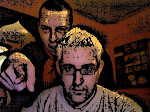I have very little time to report tonight (that stupid, stupid day job getting in the way in a horrific fashion these past few days), but a couple of major milestones with M-Brane SF have been attained lately: 1) I feel I have enough decent material in hand to make issue #1 a respectable first outing; and 2) I have begun to receive actual paid subscriptions to it! &nb...
















